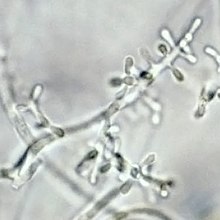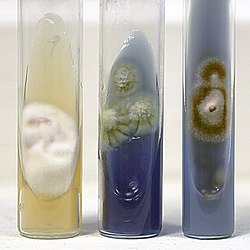Trichophyton rubrum
| Trichophyton rubrum | |
|---|---|

| |
| Microconidia of T. rubrum | |
| Scientific classification | |
| Domain: | Eukaryota |
| Kingdom: | Fungi |
| Division: | Ascomycota |
| Class: | Eurotiomycetes |
| Order: | Onygenales |
| Family: | Arthrodermataceae |
| Genus: | Trichophyton |
| Species: | T. rubrum
|
| Binomial name | |
| Trichophyton rubrum (Castell.) Sabour.
| |
| Synonyms | |
| |
Trichophyton rubrum is a
Growth and morphology
Variants
Strains of T. rubrum form two distinct biogeographical subpopulations. One is largely restricted to parts of Africa and southern Asia, while the other consists of a population that has spread around the world. Isolates of the Afro-Asiatic subpopulation most commonly manifest clinically as
Diagnostic tests
As a preliminary test indicating infection, plucked hairs and skin and nail scrapings can be directly viewed under a microscope for detection of fungal elements. T. rubrum cannot be distinguished from other dermatophytes in this direct examination. It can be distinguished in vitro from other dermatophytes by means of characteristic micromorphology in culture, usually consisting of small, tear-drop-shaped microconidia, as well as its usual blood-red colony reverse pigmentation on most growth media. In addition, the Bromocresol purple (BCP) milk solid glucose agar test can be used to distinguish it. Different Trichophyton species release different amounts of ammonium ion, altering the pH of this medium. In this test, medium supporting T. rubrum remains sky blue, indicating neutral pH, until 7 to 10 days after inoculation.[7][10] In primary outgrowth on Sabouraud dextrose agar with cycloheximide and antibacterials, contaminating organisms may cause confusion, as T. rubrum colonies deprived of glucose by competing contaminants may grow without forming the species' distinctive red pigment.[7] Both antibiotic-resistant bacteria and saprotrophic fungi may outcompete T. rubrum for glucose if they contaminate the sample. Red pigment production can be restored in such contaminated isolates using casamino acids erythritol albumin agar (CEA).[7] T. rubrum cultures can be isolated on both cycloheximide-containing media and cycloheximide-free media. The latter are conventionally used for the detection of nail infections caused by non-dermatophytes such as Neoscytalidium dimidiatum.[7] A skin test is ineffective in diagnosing active infection and often yields false negative results.[11]
Pathology
Trichophyton rubrum is rarely isolated from animals.
Trichophyton rubrum infections do not elicit strong inflammatory responses, as this agent suppresses cellular immune responses involving
Foot
Trichophyton rubrum is one of the most common causes of chronic tinea pedis commonly known as athlete's foot.
Hand
Tinea manuum is commonly caused by T. rubrum and is characterized by unilateral infections of the palm of the hand.[10]
Groin
Along with E. floccosum, T. rubrum is the most common cause of this disease, also known as 'jock itch.' Infections cause reddish brown lesions mainly on the upper thighs and trunk, that are border by raised edge.[10]
Nail
Once considered a rare causative agent,[12] T. rubrum is now the most common cause of invasive fungal nail disease (called onychomycosis or tinea unguium).[10] Nail invasion by T. rubrum tends to be restricted to the underside of the nail plate and is characterized by the formation of white plaques on the lunula that can spread to the entire nail. The nail often thickens and becomes brittle, turns brown or black.[13] Infections by T. rubrum are frequently chronic, remaining limited to the nails of only one or two digits for many years without progression.[12] Spontaneous cure is rare.[12] These infections are usually unresponsive to topical treatments and respond only to systemic therapy.[citation needed] Although it is most frequently seen in adults, T. rubrum nail infections have been recorded in children.[12]
Epidemiology
It is thought that Trichophyton rubrum evolved from a
Transmission
This species has a propensity to infect glabrous (hairless) skin and is only exceptionally known from other sites.[13] Transmission occurs via infected towels, linens, clothing (contributing factors are high humidity, heat, perspiration, diabetes mellitus, obesity, friction from clothes).[12] Infection can be avoided by lifestyle and hygiene modifications such as avoiding walking barefoot on damp floors particularly in communal areas.[12]
Treatment
Treatment depends on the locus and severity of infection. For tinea pedis, many antifungal creams such as miconazole nitrate, clotrimazole, tolnaftate (a synthetic thiocarbamate), terbinafine hydrochloride, butenafine hydrochloride and undecylenic acid are effective. For more severe or complicated infections, oral ketoconazole was historically shown to be an effective treatment for T. rubrum infections but is no longer used for this indication due to the risk of liver damage as a side effect.[14] Oral terbinafine, itraconazole or fluconazole have all been shown to be safer, effective treatments. Terbinafine and naftifine (topical creams) have been successfully treated tinea cruris and tinea corporis caused by T. rubrum.[15] Trichophyton rubrum infections have been found to be susceptible to photodynamic treatment,[16] laser irradiation,[17] and photoactivation of rose bengal dye by green laser light.[18]
Tinea unguium presents a much greater therapeutic challenge as topical creams do not penetrate the nail bed. Historically, systemic griseofulvin treatment showed improvements in some patients with tinea unguium; however, failure was common even in lengthy treatment courses (e.g., > 1 yr). Current treatment modalities include oral terbinafine, oral itraconazole, and intermittent "pulse therapy" with oral itraconazole[19][20] Fingernail infections can be treated in 6–8 weeks while toenail infections may take up to 12 weeks to achieve cure.[12] Topical treatment by occlusive dressing combining 20% urea paste with 2% tolnaftate have also shown promise in softening the nail plate to promote penetration of the antifungal agent to the nail bed.[12]
References
- ^ "Trichophyton purpureum H. Bang, - GSD Species". www.speciesfungorum.org. Species Fungorum. Retrieved 8 October 2022.
- PMID 10523582.
- ^ PMID 19098130.
- ^ William Williams, The Principles and Practice of Veterinary Surgery, p.734, W.R. Jenkins, 1894, from the collection of the University of California.
- ^ S2CID 3349369.
- PMID 10074502.
- ^ ISBN 978-0898631579.
- PMID 632806.
- PMID 22951933.
- ^ PMID 7621400.
- ^ PMID 8060745.
- ^ ISBN 978-0812108859.
- ^ ISBN 9780812114638.
- ^ Lowes, Robert (August 23, 2013). "FDA Safety Changes: Ketoconazole Linked With Liver Injury". Medscape. WebMD LLC. Retrieved November 10, 2018.
- PMID 25090020.
- PMID 28669966.
- S2CID 21874451.
- S2CID 30630519.
- PMID 8546481.
- PMID 25032982.


